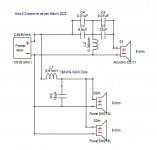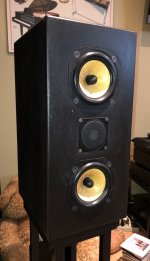Looking for feedback on if switching Solen 0.91 mH 18G solid core inductors on a pair of paralleled Focal 5K013L mid/woofers (speakers use an Accuton [Ceratech] C22-11 Tweeter) to respective 0.91 mH 16G {16G to achieve same DCR as solid core coils of 0.45 ohm} Solen Heptalitz coils would make any sonic difference in the midrange clarity? I had switched from standard Solen fast caps for the tweeters to Clarity CSA series and was a very nice upgrade in sound for tweeter! Speakers are in MTM -D'Appolito layout by the way. I understand Litz coils might only make a difference for very high frequency but might be a waste of time (and money) compared to standard solid core inductors for mid/woofer only used up to @2.5kHz. FYI using transmission line subwoofers on these these satellite speakers crossed over at 80 Hz.
Should I spend the $50 to get the Solen Heptalitz coils in replacement for standard solid core types as a final upgrade touch for the speakers...or not...?
Crossover diagram and snapshot of speakers attached for reference:
Thanks in advance for any feedback,
Gordon
Should I spend the $50 to get the Solen Heptalitz coils in replacement for standard solid core types as a final upgrade touch for the speakers...or not...?
Crossover diagram and snapshot of speakers attached for reference:
Thanks in advance for any feedback,
Gordon
Attachments
Yes indeed the in-series coils to the two mid/bass drivers is the inductor of discussion and the shunting coil to the tweeter simply shunts low frequency audio away from the tweeter thus you wouldn't hear any "quality" in the tweeter coil being in parallel to tweeter compared to woofer/midrange coil in series.
As an additional FYI for anyone looking at crossover schematic the 0.01uF bypass caps across the main tweeter capacitors are small Vishay Roederstein Polypropylenes. I picked up on some people liking the sonic affect of these tiny inexpensive bypass caps to enhance the quality of mid-priced capacitors. I suppose debatable and in all honesty had not A-B tested the sound with or without them for me to definitely know. They are only worth a few $dollars each in any event. As mentioned originally I sure do like the sound of the Clarity CSA caps on the Accuton tweeter. Wanted to try Jantzen Superior Z-Caps but they were getting a bit rich in price compared to the Claritys. Am using Mundorf Supremes on some Dynaudio D260's that work very nice (also with same 0.01uF Vishay Roederstein Polypropylenes bypass caps). Had broken the Claritys in for 400 hours before retrofitting original Solen Fast Caps on Accuton Tweeter.
As an additional FYI for anyone looking at crossover schematic the 0.01uF bypass caps across the main tweeter capacitors are small Vishay Roederstein Polypropylenes. I picked up on some people liking the sonic affect of these tiny inexpensive bypass caps to enhance the quality of mid-priced capacitors. I suppose debatable and in all honesty had not A-B tested the sound with or without them for me to definitely know. They are only worth a few $dollars each in any event. As mentioned originally I sure do like the sound of the Clarity CSA caps on the Accuton tweeter. Wanted to try Jantzen Superior Z-Caps but they were getting a bit rich in price compared to the Claritys. Am using Mundorf Supremes on some Dynaudio D260's that work very nice (also with same 0.01uF Vishay Roederstein Polypropylenes bypass caps). Had broken the Claritys in for 400 hours before retrofitting original Solen Fast Caps on Accuton Tweeter.
Pano,
Indeed to the inductor chokes off the high frequencies anyway but I am looking for anyone that can comment on any better quality of midrange experienced through a litz coil. Perhaps there might be more richness/texture & smoothness to violin recordings and better attack/presence to piano? I don't want to make up any adjectives to describe what might be advantageous (or not) through a Litz coil but need to try them or dispose of any false expectations about them...
Thx,
Gordon
Indeed to the inductor chokes off the high frequencies anyway but I am looking for anyone that can comment on any better quality of midrange experienced through a litz coil. Perhaps there might be more richness/texture & smoothness to violin recordings and better attack/presence to piano? I don't want to make up any adjectives to describe what might be advantageous (or not) through a Litz coil but need to try them or dispose of any false expectations about them...
Thx,
Gordon
Scott G,
Didn't introduce into the conversation about Copper foils but I think they might get out of hand in terms of pricing. Solen here in Canada doesn't carry them and I should investigate other vendor availability - and consider. Trying to squeeze every drop of quality (for a reasonable price) from the Focal/Accuton combination. The speaker enclosures are custom multi/laminate braced, etc. and very inert/dead sounding for the lovely Focal 5K013L Poly/Kevlar sandwich drivers (albeit dated from 1995!), not to mention the superb Accuton inverted ceramic dome tweeter!!
Didn't introduce into the conversation about Copper foils but I think they might get out of hand in terms of pricing. Solen here in Canada doesn't carry them and I should investigate other vendor availability - and consider. Trying to squeeze every drop of quality (for a reasonable price) from the Focal/Accuton combination. The speaker enclosures are custom multi/laminate braced, etc. and very inert/dead sounding for the lovely Focal 5K013L Poly/Kevlar sandwich drivers (albeit dated from 1995!), not to mention the superb Accuton inverted ceramic dome tweeter!!
The technical spec at high audio frequencies (1KHz and above) that litz brings to the table is a higher “Q” than that of a solid core wire or foil inductors of the same gauge. Above audio frequencies, foil inductors have the better Q. Below about 1KHz the DCR of the coil is the primary Q determinant.I know some people like them, but I've never understood Litz for inductors. If you are using an inductor in a crossover, you are trying to dump or impede high frequencies. Why use a wire that is better at HF if you don't want the HF?
Q is the ratio of inductive reactance to resistance at a given frequency.
A higher Q means a less lossy filter response at the crossover frequency.
They are "better" because they are more expensive.
Applies to everything.
Imagine how MUCH better would they be if made of gold Litz wire.
Back to the Real World: compare those coils side by side, use a switch to choose which one works, even better is switch is activated by somebody in another room (relay).
Do you har ANY difference at all?
IF any, which one sounds best?
Compare hits or misses to flipping a coin.
Applies to everything.
Imagine how MUCH better would they be if made of gold Litz wire.
Back to the Real World: compare those coils side by side, use a switch to choose which one works, even better is switch is activated by somebody in another room (relay).
Do you har ANY difference at all?
IF any, which one sounds best?
Compare hits or misses to flipping a coin.
Q is most important in tuned circuits, greatly influencing selectivity, notch/peak depth at resonant frequencies.The technical spec at high audio frequencies (1KHz and above) that litz brings to the table is a higher “Q” than that of a solid core wire or foil inductors of the same gauge. Above audio frequencies, foil inductors have the better Q. Below about 1KHz the DCR of the coil is the primary Q determinant.
Q is the ratio of inductive reactance to resistance at a given frequency.
A higher Q means a less lossy filter response at the crossover frequency.
Not much useful, if at all, in non resonant circuits such as highpass or lowpass crossover filters.
If used as tuned bandpass filter in series with a midrange, higher Q is WORSE: midrange will receive a narrow peak: artificial and annoying (being polite).
That crude approach has been used before, but best way to make it at least bearable is to LOWER Q so we get a flatter passband..
Pano, please skim the first three pages of this thread for Al Klappenberger’s relevant posts regarding Q and crossover filter response. At your leisure of course.OK, I can understand that. But with a filter, I want loss. I want to prevent certain signals from going certain places.
@Brinkman , it is mentioned on the page you linked..
However we're not talking about the filter Q in this thread, which that effect should be applied to. The main effect of inductor Q in these conditions is to affect the lower frequencies.Low Q inductors will show up most dramatically right at the cutoff in a filter.
Scott G,
Didn't introduce into the conversation about Copper foils but I think they might get out of hand in terms of pricing. Solen here in Canada doesn't carry them and I should investigate other vendor availability - and consider. Trying to squeeze every drop of quality (for a reasonable price) from the Focal/Accuton combination. The speaker enclosures are custom multi/laminate braced, etc. and very inert/dead sounding for the lovely Focal 5K013L Poly/Kevlar sandwich drivers (albeit dated from 1995!), not to mention the superb Accuton inverted ceramic dome tweeter!!
https://www.erseaudio.com/Products/FoilQCoils16Gauge/EAF16-910
Note quite enough resistance, close though. (..not in stock, but it is Erse and they actually make the product - but it just takes time.)
Last edited:
This does not work like a water drainage scheme. The "shunt" component represents an integral part of the network impedance that the tweeter sees.the shunting coil to the tweeter simply shunts low frequency audio away from the tweeter thus you wouldn't hear any "quality" in the tweeter coil being in parallel to tweeter compared to woofer/midrange coil in series.
Subjectively for me it's just improved clarity vs other inductors in some instances - not a matter of enhancing a higher freq. response anymore than a litz lead to the driver.I know some people like them, but I've never understood Litz for inductors. If you are using an inductor in a crossover, you are trying to dump or impede high frequencies. Why use a wire that is better at HF if you don't want the HF?
Looking for feedback on if switching Solen 0.91 mH 18G solid core inductors on a pair of paralleled Focal 5K013L mid/woofers (speakers use an Accuton [Ceratech] C22-11 Tweeter) to respective 0.91 mH 16G {16G to achieve same DCR as solid core coils of 0.45 ohm} Solen Heptalitz coils...
Thanks in advance for any feedback,
Gordon
I advise to invest your intended sum in a retirement fund which would be a better decision. Learn from other people mistakes, if you can.
JMFahey,
Of course your blind testing method is the only proper way to hear any differences between components and that is switch back and forth during many different test passages of music (simple or complex). Could rig this up in a common test environment for comparing sample: Inductors, Capacitors even resistors, not to mention drive units, cables, [gain matched] electronic devices, etc...
Of course your blind testing method is the only proper way to hear any differences between components and that is switch back and forth during many different test passages of music (simple or complex). Could rig this up in a common test environment for comparing sample: Inductors, Capacitors even resistors, not to mention drive units, cables, [gain matched] electronic devices, etc...
- Home
- Loudspeakers
- Multi-Way
- Litz coils or solid core?

